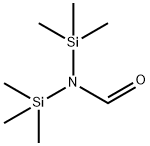
N,N-Bis(trimethylsilyl)formamide
- Product NameN,N-Bis(trimethylsilyl)formamide
- CAS15500-60-4
- CBNumberCB8480743
- MFC7H19NOSi2
- MW189.4
- EINECS239-530-4
- MDL NumberMFCD00014849
- MOL File15500-60-4.mol
- MSDS FileSDS
Chemical Properties
| Melting point | 158 °C |
| Boiling point | 158 °C |
| Density | 0.885 g/mL at 20 °C(lit.) |
| refractive index | n |
| Flash point | 37 °C |
| solubility | benzene, CCl4, CH2Cl2, CHCl3. |
| pka | 0.16±0.70(Predicted) |
| CAS DataBase Reference | 15500-60-4(CAS DataBase Reference) |
| FDA UNII | FXX3KFS75F |
| EPA Substance Registry System | Formamide, N,N-bis(trimethylsilyl)- (15500-60-4) |
Safety
| Symbol(GHS) |

|
| Signal word | Warning |
| Hazard statements | H226 |
| Risk Statements | 10 |
| RIDADR | UN 1993 3/PG 3 |
| WGK Germany | 3 |
| F | 10-21 |
| HazardClass | 3.2 |
| PackingGroup | III |
